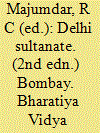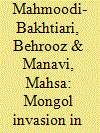| Srl | Item |
| 1 |
ID:
033429


|
|
|
|
|
| Edition |
2nd edn.
|
| Publication |
Bombay, Bharatiya Vidya Bhavan, 1967.
|
| Description |
xxxviii, 882p.: ill., mapshbk
|
| Series |
History and Culture of the Indian people
|
|
|
|
|
|
|
|
|
|
|
|
Copies: C:1/I:0,R:0,Q:0
Circulation
| Accession# | Call# | Current Location | Status | Policy | Location |
| 015983 | 954.0232/MAJ 015983 | Main | On Shelf | General | |
|
|
|
|
| 2 |
ID:
126931


|
|
|
|
|
| Publication |
2013.
|
| Summary/Abstract |
New Historicists view history as a text through whose discontinuities and breaks the repressed and suppressed voices find ways of articulation. Likewise, a literary text, in its underlying layers, alludes to the historical conditions at the time of its production. In some cases, as in Bahram Beyzaie's works, however, the author intentionally uses the past to reread the present. He recreates history as a text in which the voices repressed in the classified history are heard. As the Mongols played an important role in the history of Iran, some of Beyzaie's works pay particular attention to them. This paper analyzes some of Beyzaie's plays and screenplays to investigate the presentation of the Mongols in his fictional worlds.
|
|
|
|
|
|
|
|
|
|
|
|
|
|
|
|
| 3 |
ID:
147814


|
|
|
|
|
| Summary/Abstract |
The author suggests historical and textual comment to the most important reports of Russian chronicles, including those about the capture of Chernigov, reconciliation of the Russian princes with the Tatars, the coming of Möngke Khan to Kiev, Mikhail Vsevolodovich’s flight from Kiev, the capture of Kiev, Volodymyr Volynskyi, Berestie, and Halych. The significance of the Mongols’ stone artillery in attacking Russian cities is considered. The author compares various reports in Russian chronicles about the date of the capture of Kiev by the Mongols with information from Hungarian sources and concludes that the most trustworthy date must be 6 December 1240. Proper names Uladmur and Uchogul Uladmur given by the medieval Persian historian Rashid-ad-Din in his account of the conquest of South Rus’ by the Mongols cannot, in the opinion of the author, be related to the historical toponyms of Galician-Volhynian Rus’. The Mongol name Uladmur was connected with the name of Prince Vladimir Riurikovich, who had occupied the Kievan throne not long before the attack of the Mongols against South Rus’ and held peaceful negotiations with Prince Möngke. Based on the study of comparative-historical materials, the author concludes that in Volhynia and Galicia the Mongols used a method that they had often used before. They forced the residents of the conquered cities to go outside the city walls and massacred them. They spared only the young men suitable for military service and took them into auxiliary troops (khashar), so that they should fight in the most dangerous areas of the battle.
|
|
|
|
|
|
|
|
|
|
|
|
|
|
|
|